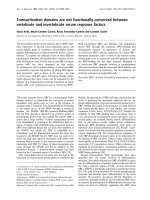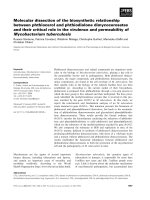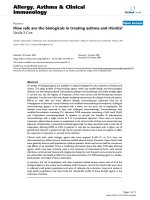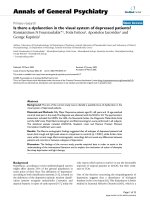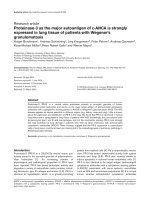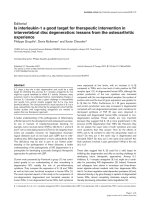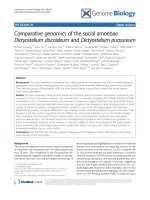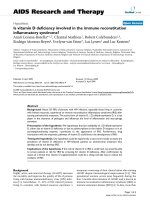Báo cáo y học: " Is neutrophil elastase the missing link between emphysema and fibrosis? Evidence from two mouse models" pps
Bạn đang xem bản rút gọn của tài liệu. Xem và tải ngay bản đầy đủ của tài liệu tại đây (1.97 MB, 14 trang )
BioMed Central
Page 1 of 14
(page number not for citation purposes)
Respiratory Research
Open Access
Research
Is neutrophil elastase the missing link between emphysema and
fibrosis? Evidence from two mouse models
Monica Lucattelli, Barbara Bartalesi, Eleonora Cavarra, Silvia Fineschi,
Benedetta Lunghi, Piero A Martorana and Giuseppe Lungarella*
Address: Department of Physiopathology & Experimental Medicine, University of Siena, 53100 Siena, Italy
Email: Monica Lucattelli - ; Barbara Bartalesi - ; Eleonora Cavarra - ;
Silvia Fineschi - ; Benedetta Lunghi - ; Piero A Martorana - ;
Giuseppe Lungarella* -
* Corresponding author
Abstract
Background: The separation of emphysema from fibrosis is not as clear-cut as it was thought in early studies.
These two pathologies may be present at the same time in human lungs and in mice either instilled with elastolytic
enzymes or bleomycin or exposed to cigarette-smoke. According to a current view, emphysema originates from
a protease/antiprotease imbalance, and a role for antiproteases has also been suggested in the modulation of the
fibrotic process. In this study we investigate in experimental animal models of emphysema and fibrosis whether
neutrophil elastase may constitute a pathogenic link between these two pathologies.
Methods: This study was done in two animal models in which emphysema and fibrosis were induced either by
bleomycin (BLM) or by chronic exposure to cigarette-smoke. In order to assess the protease-dependence of the
BLM-induced lesion, a group mice was treated with 4-(2-aminoethyl)-benzenesulfonyl fluoride hydrochloride, a
serine proteinase inhibitor active toward neutrophil elastase. Lungs from each experimental group were used for
the immunohistochemical assessment of transforming growth factor-β (TGF-β) and transforming growth factor-
α (TGF-α) and for determination of the mean linear intercept as well as the percent volume densities of fibrosis
and of emphysematous changes. Additionally, the lungs were also assessed for desmosine content and for the
determination of elastase levels in the pulmonary interstitium by means of immunoelectron microscopy.
Results: We demonstrate that in BLM-treated mice (i) the development of elastolytic emphysema precedes that
of fibrosis; (ii) significant amount of elastase in alveolar interstitium is associated with an increased expression of
TGF-β and TGF-α; and finally, (iii) emphysematous and fibrotic lesions can be significantly attenuated by using a
protease inhibitor active against neutrophil elastase.
Also, in a strain of mice that develop both emphysema and fibrosis after chronic cigarette-smoke exposure, the
presence of elastase in alveolar structures is associated with a positive immunohistochemical reaction for reaction
for both TGF-β and TGF-α.
Conclusion: The results of the present study strongly suggest that neutrophil elastase may represent a common
pathogenic link between emphysema and fibrosis. Proteases and in particular neutrophil elastase could act as
regulatory factors in the generation of soluble cytokines with mitogenic activity for mesenchymal cells resulting
either in emphysema or in fibrosis or both.
Published: 26 July 2005
Respiratory Research 2005, 6:83 doi:10.1186/1465-9921-6-83
Received: 29 April 2005
Accepted: 26 July 2005
This article is available from: />© 2005 Lucattelli et al; licensee BioMed Central Ltd.
This is an Open Access article distributed under the terms of the Creative Commons Attribution License ( />),
which permits unrestricted use, distribution, and reproduction in any medium, provided the original work is properly cited.
Respiratory Research 2005, 6:83 />Page 2 of 14
(page number not for citation purposes)
Background
Lung emphysema and fibrosis are generally considered to
be two diseases that totally differ in their morphological
aspects and pathogenic mechanisms.
However, both these pathologies may be present at the
same time in lungs of mice after cigarette-smoke exposure
[1], in animals instilled intratracheally with BLM or other
substances [2-5], as well as in human lungs [6]. In partic-
ular, in smokers and ex-smokers, centrilobular emphy-
sema may be associated with some subsets of idiopathic
interstitial pneumonias (IIP), namely "desquamative
interstitial pneumonia" (DIP), "respiratory bronchiolitis-
associated lung disease" (RB-ILD), and finally "idiopathic
pulmonary fibrosis" (IPF) also characterized by the histo-
logical pattern of "usual interstitial pneumonia" (UIP).
This has been clearly outlined in a recent document of the
ATS/ERS defining the clinical manifestations, pathology
and radiologic features of patients with IIP [7]. These data
all together suggest a common pathway in the develop-
ment of these two pathologies.
According to a current view, pulmonary emphysema orig-
inates from an imbalance between elastinolytic proteases
and their naturally occurring inhibitors. In particular,
neutrophil elastase (NE), and other elastolytic proteases,
such as cathepsin G, and macrophage elastase are thought
to be the main causative factors of tissue damage in this
condition. This hypothesis is based on a mixture of evi-
dence from animal models, broncho-alveolar lavage fluid
(BALF) data, in vitro experiments, and from the high inci-
dence of emphysema in homozygous subjects with a defi-
ciency of α
l
-proteinase inhibitor (α
1
-PI) [8,9].
Recently, it has been reported that α
1
-PI, the secretory leu-
kocyte protease inhibitor (SLPI), as well as the synthetic
inhibitor of leukocyte elastase ONO-5046, significantly
attenuate the fibrotic response to BLM in rodents [10-12].
In man, the inactivation of proteolytic enzymes may also
be a critical event in normal repair, and as demonstrated
in infants with respiratory distress syndrome, lack of anti-
protease activity is associated with chronicity and devel-
opment of fibrosis [13].
Thus, these studies suggest a significant role for the anti-
protease screen not only in the development of pulmo-
nary emphysema but also in the modulation of fibrotic
lesions. This is further supported by studies carried out in
BLM-challenged mice either with a genetic deficiency in
α
1
-PI [4], or with a targeted deletion of the NE gene [14].
As previously reported by us, BLM administration induces
alveolitis and fibrosis in α
1
-PI deficient mice. It also
results in enlargement of air spaces that may be due either
to loss of alveolar septa and/or retraction forces caused by
the fibrotic process [4].
In this study we investigate whether NE may constitute a
pathogenic link between emphysema and fibrosis. This
was done in two animal models in which these two
pathologies were induced either by BML or chronic expo-
sure to cigarette smoke. In order to assess the protease-
dependence of the BLM-induced lung lesion under our
experimental conditions, a group mice was treated with 4-
(2-aminoethyl)-benzenesulfonyl fluoride hydrochloride,
a serine proteinase inhibitor fully active against NE [15].
Methods
Animals and Animal Studies
Balb/c, C57 Bl/6 and DBA/2 mice were supplied by Charles
River (Calco, Italy). C57 Bl/6J pa/pa (pallid) mice were
from our colony and were originally obtained from Jack-
son Laboratory (Bar Harbor, ME, USA). All animal exper-
iments were conducted in conformance with the "Guiding
Principles for Research Involving Animals and Human
Beings" and approved by the Local Ethical Committee of
the University of Siena.
Bleomycin Study
The study was carried out by using strains of mice with dif-
ferent levels of serum antielastase screen (Balb/c, C57 Bl/6
and pallid, with normal, intermediate and low screen,
respectively) [16]. Male mice, weighing 20 to 25 g (8–10
wk old) were treated under ether anaesthesia with a single
intratracheal instillation of 0.1 µg BLM (Rhone-Poulenc
Rorer, Milano, Italy) in saline solution (50 µl) or with the
same amount of saline. At 3, 7, 14, 21, 28 and 35 days
after the treatment, animals were killed by pentobarbital
sodium overdose and exsanguinated by cutting the
abdominal aorta. Lungs were used for immunohisto-
chemistry of TGF-β and TGF-α and for determination of
the mean linear intercept (Lm) [17] as well as the percent
volume densities of fibrosis Vv(f) and emphysematous
changes Vv(e). Details of the morphometric assessment
are given below. Lungs were also assessed for desmosine
[18] and for determination of the elastase burden by
immunoelectron microscopy [19].
Animal treatment with a synthetic serine-proteinase inhibitor
In order to assess the protease-dependence of the BLM-
induced lung lesion under our experimental conditions
two groups of ten C57 Bl/6 mice were treated with either
4-(2-aminoethyl)-benzenesulfonyl fluoride hydrochlo-
ride (Merck), a serine proteinase inhibitor, or with the
vehicle (controls). This inhibitor (2.4 µg/µl saline) was
continuously delivered at a rate of 0.5 µl/hr for two weeks
by means of osmotic pumps (Alzet 2002, Alza Corpora-
tion, Palo Alto, CA). The pumps were implanted subcuta-
neously according the manufacturer's instructions, 24 hr
Respiratory Research 2005, 6:83 />Page 3 of 14
(page number not for citation purposes)
before BLM-treatment. At 7 and 14 days after instillation
with BLM, the lungs were excised, processed for histology,
and used for morphometrical assessment of emphysema-
tous and fibrotic lesions as well as for TGF-β and TGF-α
immunohistochemistry.
Cigarette Smoke Study
Two months old male mice of the strain DBA/2 were
exposed to either the smoke of 3 cigarettes/day (commer-
cial Virginia filter cigarettes: 12 mg of tar and 0.9 mg of
nicotine), 5 days/week, or to room air (controls), for var-
ious periods of time (from 1 to 6 months) as previously
described in detail [20]. Groups of 8 animals were sacri-
ficed during the chronic exposure period at various time
intervals. The lungs were excised and processed for histol-
ogy. Histological sections were stained with hematoxylin-
eosin and Masson's trichrome. Morphometric assessment
of emphysema included the determination of the Lm [17]
and of the internal surface area (ISA) estimated by the Lm
method at postfixation lung volume [21]. Fibrosis was
assessed by point counting as Vv(f) as described below.
Tissue sections were also stained for TGF-β, TGF-α and
NE.
Methodologies
Lung desmosine assay
To quantitate lung elastin, the lungs of each group were
weighed, homogenised (1:5, w:v) and hydrolysed in 6 N
HC1 before biochemical determinations. Desmosine was
analysed on hydrolysates by means of an enzyme-linked
immunosorbent assay essentially according to Cocci et al.
[18]. Briefly, rabbit antiserum to desmosine-hemocyanin
conjugate (Abl) (Elastin Product Company, Inc, Owens-
ville, MO) was incubated with desmosine standard (0–30
ng) (Elastin Product Company, Inc, Owensville, MO) or
with adequately diluted hydrolysates for 16 h at room
temperature. At the same time, microtiter plates (Sigma)
were incubated with 0.5 µg of desmosine-albumin conju-
gate (Elastin Product Company, Inc, Owensville, MO) in
0.05 M sodium carbonate buffer pH 9.6 at 4°C. After
incubation, wells were washed five times with 0.05%
Tween 20 in 0.15 M PBS, pH 7.2 and saturated with
0.05% Tween 20 in 0.15 M PBS, 1% BSA pH 7.2 for 1 h at
room temperature. Eightfold aliquots of AbI-standard or
AbI-sample solutions were then added to the wells for a 2
h incubation at room temperature. Wells were then in suc-
cession incubated with anti-rabbit IgG (1:2000) (Sigma)
for 2 h at room temperature and with peroxidase-antiper-
oxidase complex (1:200) (Sigma) for 1 h at room temper-
ature. 2,2'-Azino-bis (3-ethyl-benz-thiazoline-6-sulfonic
acid) solution (Sigma) was then added to the wells. After
incubation for 1 h at room temperature, absorbance was
read at 405 nm. Data were expressed as µg/lung.
Morphology and Morphometry
The lungs from the different groups of mice were fixed by
intra-tracheal inflation with buffered formalin (5%) at a
constant pressure of 20 cm H
2
O at least for 24 hours. All
lungs were then dehydrated, cleared in toluene, and
embedded in paraffin. Sagittal sections (7 µm) of each
pair of lungs were cut and stained with hematoxylin/eosin
and Masson's trichrome stain. Morphometric assessment
consisted of the determination by point counting, of the
percent volume densities of fibrosis Vv(f) and of the
emphysematous changes Vv(e) according to the stereolog-
ical principle of Glagoleff and Weibel [22]: Vv = Pp, where
Vv is the volume density and Pp the fraction of points
superimposed a defined structural change. Point counting
was performed at 100 × by determining 20 random fields
per slide and using a multipurpose grid to count 45 points
per field for a total of 900 points per slide. Fibrosis was
defined as: "inflammatory and mesenchymal cell infiltra-
tion within the alveolar septa and alveolar spaces with
deposition of extracellular matrix", and emphysematous
changes were defined as: "abnormal enlargement of air
spaces with loss of alveolar septa, and with or without
thickening of the alveolar walls" [4].
The morphometric assessment of emphysema was also
performed in all animals by determining the average
inter-alveolar distance (mean linear intercept: Lm) [17].
For the determination of the Lm for each pair of lungs, 40
histological fields were evaluated both vertically and hor-
izontally. Care was taken to avoid histological fields con-
taining large bronchi, major vessels and areas of fibrosis.
Immunohistochemistry
For the immunohistochemical studies, tissue sections (8
µm) were stained for TGF-β, TGF-α and NE by an immu-
noperoxidase method. The sections were pre-treated with
3% hydrogen peroxide to inhibit the activity of the endog-
enous peroxidase. For antigen retrieval, the sections were
heated in a microwave for 20 min in citrate buffer 0.01 M,
pH 6.0, and allowed to cool slowly to room temperature.
All the sections were incubated with 3% bovine serum
albumin for 30 min at room temperature to block non-
specific antibody binding. They were then incubated over-
night at 4°C with the primary antibodies (Ab). The pri-
mary polyclonal Ab used were: rabbit Ab to mouse TGF-a
diluted 1:50 (Santa Cruz Biotechnology, Inc., Santa Cruz,
CA), rabbit Ab to mouse TGF-α diluted 1:20 (Insight Bio-
technology LTD., Wembley, England). For elastase detec-
tion we used rabbit Ab to human neutrophil elastase
(cross-reacting with mouse neutrophil elastase) diluted
1:500 (Calbiochem-Novabiochem, San Diego, CA). All
the sections were rinsed and incubated with sheep anti-
rabbit IgG for 30 min at room temperature. The staining
was revealed by adding peroxidase-antiperoxidase com-
plex, prepared from rabbit serum. Detection was
Respiratory Research 2005, 6:83 />Page 4 of 14
(page number not for citation purposes)
accomplished by incubating in diamino-benzidine freshly
dissolved in 0.03% H
2
O
2
in 50 mM Tris-HCl pH 7.6. As
negative controls for the immunostaining the primary
antibodies were replaced by non-immunised rabbit
serum. The sections were counterstained with
hematoxylin.
Determination of elastase burden by immunoelectron microscopy
The immunogold method (post-embedding technique)
was used to localize elastase in thin lung sections prepared
for electron microscopy using anti-mouse neutrophil
elastase (MNE) antibodies obtained as previously
described [19]. Lung tissue blocks (5/animal) were taken
from two animals from each group. The blocks, 1 to 2 mm
in thickness, were fixed for 3 hours in 4% paraformalde-
hyde and 0.1% glutaraldehyde in 0.1 M phosphate buffer
(pH 7.2), dehydrated in acetone, and embedded in epoxy
resin (Araldite) without postfixation in OsO
4
. Ultrathin
sections (600 Å thick) were picked up on nickel grids and
pretreated with phosphate-buffered saline containing 1%
ovalbumin for 5 minutes. The grids were then floated on
a drop of diluted anti-MNE antibodies (1:2600) for 48 h
at 4°C; the grids were thoroughly rinsed for 10 min with
a mild spray of phosphate-buffered saline and then dis-
tilled water and transferred onto 15 µl drops of a protein
A-gold particles (15 nm) (E-Y-LABS, San Mateo, CA) solu-
tion diluted 1:8 in phosphate-buffer saline. The sections
were then washed, dried, stained with uranyl acetate-lead
citrate, and examined in a Philips 300 electron micros-
copy. Ten to 12 micrographs (final magnification, ×
12,000) were taken for each grid. To exclude false-positive
labeling, a series of control studies (including also the use
of nonimmune rabbit serum or of BSA instead of ovalbu-
min) were carried out as previously described in detail
[19]. The density of gold particles per square micrometer
of lung tissue was determined for each of the micrographs
with a superimposed quadratic lattice grid. A total of 50
micrographs was thus analyzed for each animal, and the
average of gold particle density on lung connective tissue
of each group was calculated.
Statistical Analysis
The significance of differences of the mean values was cal-
culated using one-way ANOVA (F-test). A p value of less
than 0.05 was considered significant.
Results
Bleomycin Study
Emphysema and Fibrosis after Bleomycin
The kinetics of the emphysematous and fibrotic changes
obtained in the three strains of mice are reported in Fig 1
A and 1 B. In particular, we present the percent values of
lung volume densities of fibrotic (Vv(f)) and emphysema-
tous (Vv(e)) changes obtained at the various time points.
In BLM-resistant Balbc mice with a normal antiprotease
protection, negligible foci of cellular infiltration and
fibrosis and no areas of air-space enlargements were
detected during the period of the study. On the contrary,
a progressive increase of areas of air space enlargement
and fibrosis were seen in BLM-prone C57 Bl/6 and pallid
Emphysema and fibrosis after bleomycin challengeFigure 1
Emphysema and fibrosis after bleomycin challenge.
The volume densities of emphysematous changes (Vv(e)) (A)
and fibrosis (Vv(f)) (B) were quantitated by morphometry
(point counting) on hematoxylin/eosin or Masson's tri-
chrome stained lung sections, at various times after bleomy-
cin. Data from 10 animals for each time point are given as
mean ± SEM of per cent lung volume densities. *: p < 0.01
versus respective untreated controls (0 days).
Respiratory Research 2005, 6:83 />Page 5 of 14
(page number not for citation purposes)
mice with a mild and a marked deficiency of α1-PI,
respectively.
At 3 and 7 days after BLM, C57 Bl/6 and pallid mice
showed appreciable morphologic emphysema with spotty
areas of inflammatory cell infiltration in the absence of
fibrotic changes (Figs 2 and 3). At these times the anatom-
ical emphysema was associated with a significant increase
of the Lm (Fig. 4 A) a significant decrease in lung desmo-
sine content (Fig. 4 B) and a high neutrophil elastase bur-
den (Fig. 4 C).
At 14 days after BLM, air spaces enlargements affected
6,68 ± 3.11 % and 12.71 ± 4.17 % (p < 0.01) of lung in
C57Bl/6 and pallid mice, respectively (Fig. 1 A). At this
time, the lungs of C57 Bl/6 and pallid mice showed also
Histological appearance of C57 BI/6 mouse lungs 3 and 7 days following bleomycin challengeFigure 2
Histological appearance of C57 BI/6 mouse lungs 3 and 7 days following bleomycin challenge. (A) Histologic sec-
tion from the lung of a C57 Bl/6 mouse treated with saline showing a normal parenchyma. Representative histologic sections of
C57 Bl/6 mice at 3 (B) and 7 (C and D) days after bleomycin treatment showing appreciable morphologic emphysema but not
fibrosis. Scattered inflammatory cells are present through lung parenchyma (E). (E) Shows a higher magnification of (D). (A-C):
Hematoxylin-eosin stain, scale bar represents 400 µm. (D) and (E): Masson's trichrome stain, original magnification × 40 and ×
100, respectively. Scale bars represent 400 µm and 100 µm, respectively.
Respiratory Research 2005, 6:83 />Page 6 of 14
(page number not for citation purposes)
large areas of fibrosis which involved 24.11 ± 8.81 and
36.84 ± 11.47 % of the lungs, respectively (Fig. 1 B). Both
lesions were widely spread and intermixed (Fig. 5 A). Nev-
ertheless, areas of emphysema could also be detected in
lung lobes without any fibrotic reaction. Additionally, in
several areas the emphysematous changes were distant
from the fibrotic foci (Fig. 5 B and 5 C).
At later times (21 days onward), the volume density of
emphysematous and fibrotic changes markedly increased
(Fig. 1 A and 1 B). From a morphological point of view,
the emphysematous lesions appeared to be mainly of
paracicatricial type (Fig. 6 A and 6 B). Nevertheless, large
areas of emphysema could also be found in lung lobes
without obvious fibrosis or situated adjacent to the
fibrotic lesions (Fig. 6 C).
No significant changes in terms of emphysema or fibrosis
were seen after BLM treatment in Balb/c mice with normal
levels of serum αl-PI, by morphological, morphometrical
and biochemical analysis.
Immunohistochemistry
Lungs of mice from the three strains were also analysed for
cytokine expression by immuno-histochemistry. A signif-
icant change of some cytokines related to the NE activity
was observed in mice with a mild (C57 Bl/6) and a
marked deficiency (pallid) of αl-PI, after BLM administra-
tion. In particular, TGF-β was detected in subpleural foci
of cellular proliferation at 7 days (Fig. 7 A) when an
increase of the elastase burden could also be demon-
strated. Also at 7 days, an evident staining for TGF-α was
observed in subpleural and peribronchiolar areas (Fig. 7
B).
Effects of a serine proteinase inhibitor treatment on BLM-induced
lesions
The treatment of animals with 4-(2-aminoethyl)-benze-
nesulfonyl fluoride hydrochloride, a serine-proteinase
inhibitor, significantly prevented the BLM-induced
lesions in C57 Bl/6 mice. In particular, treated animals
showed 14 days after BLM treatment no areas of emphy-
sema and only trivial foci of fibrotic reaction (Fig. 8 A, and
8 B). The Lm values (40.75 ± 0.91 µm) and the lung
(Vv(e)) (0.93 ± 0.89 %) in these mice were not signifi-
cantly different from those observed in control mice (Lm:
39.71 ± 0.80 µm; Vv(e): 0.26 ± 0.74 %). In addition the
lung (Vv(f)) (14.13 ± 6.21 %) in mice receiving BLM plus
proteinase inhibitor was significantly lower (p < 0.01)
than that observed in mice receiving only BLM (24.11 ±
9.41 %).
No immunological reaction for TGF-α and a faint positive
staining TGF-β was found 7 days after BLM administration
Histological appearance of pallid mouse lungs 7 days following bleomycin challengeFigure 3
Histological appearance of pallid mouse lungs 7 days following bleomycin challenge. (A) Histologic section from
the lung of a pallid mouse treated with saline showing a normal parenchyma. Lung sections of pallid mice at 7 days after bleomy-
cin showing appreciable emphysema (B) and spotty areas of inflammatory cell infiltration without fibrosis (C). (A) and (B):
Hematoxylin-eosin stain, scale bar represents 400 µm. (C): Masson's trichrome stain, scale bar represents 100 µm.
Respiratory Research 2005, 6:83 />Page 7 of 14
(page number not for citation purposes)
in animals treated with 4-(2-aminoethyl)-benzenesulfo-
nyl fluoride hydrochloride (data not shown).
Cigarette Smoke Study
The results of the morphometric assessment at various
time points are shown in Fig. 9. Already at 3 months of
smoke exposure the DBA/2 mice showed overt emphy-
sema (Fig. 10 B) characterized by significant changes both
of the Lm (+ 19 %, p < 0.01) and of the internal surface
area (ISA) (-16 %, p < 0.01) (Fig.9). At this time, immu-
nohistochemical examination revealed a positive reaction
for mouse NE on the alveolar septa (Fig. 10 C). Of inter-
est, the first foci of fibrosis were seen after 4 months of
smoke exposure (Fig. 11 A) and their severity progres-
sively increased with time reaching at 6 months a (Vv(f))
value of 5.53 ± 2.11 %. At 6 months after smoke exposure,
the fibrotic lesions consisted mainly of subpleural foci. In
some areas, the fibrotic reaction was seen in the lung
parenchyma associated or not with foci of emphysema
(Fig. 11 B).
A positive immunohistochemical reaction for TGF-β and
TGF-α could be demonstrated starting from 3 months of
smoke exposure onwards (Figs. 12 A and 12 B). In general,
these cytokines were detected in foci of cellular prolifera-
tion and subsequently (from 4 months onward) in subp-
leural and parenchymal areas of fibrosis.
Discussion
Although lung emphysema and fibrosis may result from
two distinct and apparent opposite processes, they may
coexist either in different areas, or in a same area of the
lung of humans and animals. The development and the
degree of these morphological responses that generally
follow, or exacerbate, an acute or chronic inflammation
can be influenced by many individual factors, such as
cytokine production, variation in collagen synthesis and
deposition, antiprotease screen and antioxidant status
[23-30].
The findings reported in this paper strongly suggest that
NE may represent a common factor affecting the develop-
ment of both emphysema and fibrosis.
In particular, we demonstrate that in mice BLM-treated
which are genetically deficient in αl-PI (i) emphysema
and fibrosis may coexist either in different areas, or in a
same lung area; (ii) the development of emphysema pre-
cedes that of fibrosis; (iii) the development of emphyse-
matous lesions, shortly after BLM administration, is
preceded by an alveolar elastolytic burden and is matched
by a marked decrease in lung desmosine content; and
finally, (iiii) an evident staining for TGF-β and TGF-α is
observed when an increased neutrophil elastase burden
can also be demonstrated. Similarly, we found in lungs of
Mean linear intercepts, lung desmosine and elastase burden in various strains of mice following bleomycin challengeFigure 4
Mean linear intercepts, lung desmosine and elastase
burden in various strains of mice following bleomycin
challenge. (A) Mean linear intercepts (Lm) in Balb/C, C57 Bl/
6 and pallid mice after bleomycin challenge. Data are from 10
animals for each time point and are given as mean ± SD. *: p
< 0.01 versus respective saline-treated group. (B) Lung
desmosine content in Balb/C, C57 Bl/6 and pallid mice after
bleomycin treatment. Data from 10 animals for each time
point are given as mean ± SD and represent per cent change
over respective saline-treated controls (Balb/C: 2.50 ± 0.28
µg/lung; C57 BI/6: 2.48 ± 0.30 µg/lung; pallid: 2.44 ± 0.32 µg/
lung). *: p < 0.01 versus respective saline-treated group. (C)
Lung elastase burden in Balb/C, C57 Bl/6 and pallid mice at 7
days after bleomycin treatment. Data are given as mean ± SD
of the number of gold particles per µm
2
. *: p < 0.01 versus
respective saline-treated group.
Respiratory Research 2005, 6:83 />Page 8 of 14
(page number not for citation purposes)
Histological appearance of pallid and C57 Bl/6 mouse lungs 14 days following bleomycin challengeFigure 5
Histological appearance of pallid and C57 Bl/6 mouse lungs 14 days following bleomycin challenge. Representa-
tive lung histologic sections of a pallid (A) and a C57BI/6 (B) mouse at 14 days after bleomycin. Fibrotic and emphysematous
areas are widely spread and intermixed. Emphysema is often located quite distant from the fibrotic reaction (A-B).(C) shows a
higher magnification of (B). (A): Hematoxylin-eosin stain, scale bar represents 400 µm. (B) and (C): Masson's trichrome stain,
scale bars represent 400 µm and 100 µm, respectively.
Histological appearance of C57 BI/6 and pallid mouse lungs 21 days following bleomycin challengeFigure 6
Histological appearance of C57 BI/6 and pallid mouse lungs 21 days following bleomycin challenge. Histologic
sections from lungs of a C57BI/6 (A and C) and pallid (B) mouse at 21 days after bleomycin. The emphysematous lesions within
or adjacent to the fibrotic areas appear to be mainly of the paracicatricial type (A and B). Nevertheless, several areas of emphy-
sema can be detected quite distant from the fibrotic zones (C). (A) and (C): Hematoxylin-eosin stain, scale bar represents 400
µm. (B): Masson's trichrome stain, scale bar represents 400 µm.
Respiratory Research 2005, 6:83 />Page 9 of 14
(page number not for citation purposes)
mice after cigarette-smoke exposure that (i) emphysema
and fibrosis may be present in the same lung; (ii) the
development of the emphysematous lesions occur at
earlier time points than that of the fibrotic foci, and (iii) a
positive immunohistochemical reaction for neutrophil
elastase is associated with a positive reaction for TGF-β
and TGF-α two major fibrogenic cytokines (i.e. [31,32] in
foci of cellular proliferation, and in areas of fibrosis.
Taken all together these results indicate that the air-space
enlargements observed in mice with a genetic deficiency
of serum α
l
-PI, early after BLM, represent areas of "true"
emphysema caused by a proteolytic attack and character-
ised by lung desmosine loss. The strong immunoelectron
microscopical reaction for NE found on alveolar septa of
α
l
-PI deficient mice early after BLM and in DBA/2 mice
after cigarette smoke suggests that NE may represent a
common factor affecting the development of both
emphysema and fibrosis.
Immunohistochemical reaction for TGF-β and TGF-α 7 days following bleomycin challengeFigure 7
Immunohistochemical reaction for TGF-β and TGF-
α 7 days following bleomycin challenge. Lung paren-
chyma of a C57BI/6 mouse at 7 days after bleomycin treat-
ment. (A) Immunohistochemical reaction for TGF-β.
Counterstained with hematoxylin, scale bar represents 40
µm. (B) Immunohistochemical reaction for TGF-α. Counter-
stained with hematoxylin, scale bar represents 25 µm.
Histological appearance of C57 BI/6 lung receiving 4-(2-ami-noethyl)-benzenesulfonyl fluoride hydrochloride 21 days after bleomycin challengeFigure 8
Histological appearance of C57 BI/6 lung receiving 4-
(2-aminoethyl)-benzenesulfonyl fluoride hydrochlo-
ride 21 days after bleomycin challenge. Representative
histological section of a C57BI/6 mouse, receiving 4-(2-ami-
noethyl)-benzenesulfonyl fluoride hydrochloride and bleomy-
cin, at 14 days after the treatment. No appreciable areas of
emphysema are detectable in the lung parenchyma (A). Few
trivial foci of fibrosis can be appreciated in some areas (B).
(B) shows a higher magnification of (A). (A) and (B): Masson's
trichrome stain, scale bars represent 400 µm and 50 µm,
respectively.
Respiratory Research 2005, 6:83 />Page 10 of 14
(page number not for citation purposes)
Mean linear intercepts and lung internal surface areas of DBA/2 mice at various time-points during chronic cigarette smoke exposureFigure 9
Mean linear intercepts and lung internal surface areas of DBA/2 mice at various time-points during chronic cig-
arette smoke exposure. Mean linear intercept (LM) (A) and internal surface area /ISA) (B) of the lungs of DBA/2 mice at var-
ious time-intervals during chronic exposure to cigarette smoke. Data from 8 animals for each time point are given as mean ±
SD. * p < 0.05 versus air-exposed controls.
Respiratory Research 2005, 6:83 />Page 11 of 14
(page number not for citation purposes)
Lung histology and immunohistochemical reaction for neutrophil elastase in DBA/2 mice 3 months after chronic cigarette smoke exposureFigure 10
Lung histology and immunohistochemical reaction for neutrophil elastase in DBA/2 mice 3 months after
chronic cigarette smoke exposure. Lung parenchyma from an air-exposed (A) and a smoke-exposed DBA/2 (B) mouse, at
3 months. Hematoxylin-eosin stain, scale bar represents 400 µm. (C) and (D): Immunohistochemical reaction for neutrophil
elastase on alveolar septa of DBA/2 mouse at 3 months after cigarette smoke exposure in absence (C) or in presence of the
primary antibody (D). Scale bar represents 25 µm.
Respiratory Research 2005, 6:83 />Page 12 of 14
(page number not for citation purposes)
This hypothesis is further supported by the data obtained
in BLM-treated C57 B1/6J mice in which both emphy-
sema and fibrosis were significantly attenuated by the use
of a serine proteinase inhibitor active against NE. Of
interest, in these animals no immunological reaction for
TGF-α and only a faint positive staining for TGF-β could
be demonstrated. Although there is no ideal animal
model, including the BLM one, that mimics human idio-
pathic pulmonary fibrosis, the data reported here support
a role for proteases, and in particular for NE, in both these
two pathologies.
Histological appearance of DBA/2 lungs 4 and 6 months after chronic cigarette smoke exposureFigure 11
Histological appearance of DBA/2 lungs 4 and 6
months after chronic cigarette smoke exposure. Lung
parenchyma from smoke-exposed DBA/2 mice, at 4 (A) and 6
months (B). The first foci of subpleural fibrosis are seen from
4 months of smoke exposure (A). After 6 months of ciga-
rette smoke exposure, disseminated foci of severe emphy-
sema and evident areas of subpleural fibrosis are present (B).
(A) and (B): Hematoxylin-eosin stain, Scale bars represent 25
µm and 400 µm. respectively.
Immunohistochemical reaction for TGF-β and TGF-α 3 months after chronic cigarette smoke exposureFigure 12
Immunohistochemical reaction for TGF-β and TGF-
α 3 months after chronic cigarette smoke exposure.
Lung parenchyma of a smoke-exposed DBA/2 mouse, at 3
months. (A) Immunohistochemical reaction for TGF-β.
Counterstained with hematoxylin, scale bar represents 40
µm. (B) Immunohistochemical reaction for TGF-α. Counter-
stained with hematoxylin, Scale bar represents 15 µm.
Respiratory Research 2005, 6:83 />Page 13 of 14
(page number not for citation purposes)
It is well know that proteases released by inflammatory
cells recruited at the site of inflammation may be involved
in the intracellular as well as extracellular route of catabo-
lism of interstitial proteins. These proteases may play an
important role in tissue injury and repair by degrading the
components of the extracellular matrix [33]. During the
reparative responses they can remove scar tissue influenc-
ing in this way the morphological end-point.
It is generally accepted that NE plays a role in the develop-
ment of emphysematous lesions. It acts on a large variety
of substrates, in particular elastin, collagens, fibronectin,
laminin and proteoglycans [23]. Recent studies suggest
that this enzyme may modulate the fibrotic response also
by interacting with the cytokine network. NE can activate
or inactivate by proteolytic cleavage several cytokines,
receptors and polypeptide growth factors implicated in
inflammation and reparative phases of the fibrotic
response [34-37].
In this regard, NE constitutes an important factor for the
generation of soluble TGFα [32], a potent mitogenic
cytokine for mesenchymal cells. In fact, TGFα is activated
by the cleavage of the membrane precursor pro-TGFα by
elastase [38,39].
Additionally, NE modulates TGF-β bioactivity [35] either
directly by releasing TGF-β1 from the extracellular matrix
[40] or indirectly via MMP-12 [41].
Of interest, we found that TGFα and TGFβ immunoreac-
tivity was significantly high in mice that develop foci of
subpleural fibrosis after cigarette-smoke or BLM treatment
when a positive reaction for mouse NE on the alveolar
septa was found. Although the association between the
development of foci of subpleural fibrosis and a positive
reaction for mouse NE on the alveolar septa does not
prove a causal relationship, the data presented here
strongly support the hypothesis that NE may represent a
common pathogenic link between emphysema and
fibrosis.
Conclusion
In conclusion the data reported in this paper strongly sug-
gest a significant role for the NE not only in the develop-
ment of pulmonary emphysema, but also in the
modulation of fibrotic lesions. The results may also offer
an explanation for the antifibrotic activity of some pro-
tease inhibitors (i.e. α
l
-PI, SLPI and the synthetic inhibitor
ONO-5046) that are all active against NE.
Competing interests
The author(s) declare that they have no competing
interests.
Authors' contributions
ML played a major role in the design of the study, acqui-
sition, analysis and interpretation of data and drafting the
manuscript. BB and BL performed the histological and
morphometrical analyses, and contributed to the inter-
pretation of the results. EC and SF performed histochem-
ical and biochemical analyses, carried out animal studies
and participated in the interpretation of data. PAM
performed some of the morphometrical analysis and con-
tributed to the interpretation of data. GL conceived and
coordinated the study, participated in the design of the
study, analysis and interpretation of data and drafting the
manuscript. All authors read and approved the final
manuscript.
Acknowledgements
This work was supported by a grant from MIUR (Rome, Italy) and partially
by a PAR grant (University of Siena, Italy)
References
1. Bartalesi B, Cavarra E, Fineschi S, Lucattelli M, Lunghi B, Martorana
PA, Lungarella G: Different lung responses to cigarette smoke
in two strains of mice sensitive to oxidants. Eur Respir J 2005,
25:15-22.
2. Lucey EC, Ngo HQ, Agarwal A, Smith BD, Snider GL, Goldstein R:
Differential expression of elastin and α
l
(I) collagen mRNA in
mice with bleomycin-induced pulmonary fibrosis. Lab Invest
1996, 74:12-20.
3. Yaekashiwa M, Nakayama S, Ohnuma K, Sakai T, Abe T, Satoh K, Mat-
sumoto K, Nakamura T, Takahashi T, Nukiwa T: Simultaneous or
delayed administration of hepatocyte growth factor, equally
represses the fibrotic changes in murine lung injury induced
by bleomycin. Am J Respir Crit Care Med 1997, 156:1937-1944.
4. Cavarra E, Martorana PA, Bartalesi B, Fineschi S, Gambelli F, Lucattelli
M, Ortiz L, Lungarella G: Genetic deficiency of α
l
-PI in mice
influences lung responses to bleomycin. Eur Respir J 2001,
17:474-480.
5. Niewoehner DE, Hoidal JR: Lung fibrosis and emphysema:
divergent responses to a common injury? Science 1982,
217:359-360.
6. Lang MR, Fiaux GW, Gillooy M, Stewart JA, Hulmes DJS, Lamb D:
Collagen content of alveolar wall tissue in emphysematous
and non-emphysematous lungs. Thorax 1994, 49:319-326.
7. American Thoracic Society: American Thoracic Society/Euro-
pean Respiratory Society International Multidisciplinary
Consensus Classification of the Idiopathic Interstitial
Pneumonias. Am J Respir Crit Care Med 2002, 165:277-304.
8. Tuder RM, Voelkel NF: The pathobiology of chronic bronchitis
and emphysema. In Chronic obstructive pulmonary disease Edited by:
Voelkel NF, MacNee W. Hamilton, Ontario, Canada: BC Decker Inc;
2002:90-113.
9. Snider GL, Martorana PA, Lucey EC, Lungarella G: Animal models
of emphysema. In Chronic obstructive pulmonary disease Edited by:
Voelkel NF, MacNee W. Hamilton, Ontario, Canada: BC Decker Inc;
2002:237-256.
10. Nagai A, Aoshiba K, Ishihara Y, Inano H, Sakamoto K, Yamaguchi E,
Kagawa J, Takizawa T: Administration of α
l
-proteinase inhibitor
ameliorates bleomycin-induced pulmonary fibrosis in
hamsters. Am Rev Respir Dis 1992, 145:651-658.
11. Mitsuhashi H, Asano S, Nonaka T, Hamamura I, Masuda KI, Kiyoki M:
Administration of truncated secretory leukoprotease inhibi-
tor ameliorates bleomycin-induced pulmonary fibrosis in
hamsters. Am J Respir Crit Care Med 1996, 153:369-374.
12. Taoka Y, Maeda A, Hiyama K, Ishioka S, Yamakido M: Effects of neu-
trophil elastase inhibitor on bleomycin-induced pulmonary
fibrosis. Am J Respir Crit Care Med 1997, 156:260-265.
13. Merritt TA, Cochrane CG, Holcomb K, Bohl B, Hallman M, Strayer
D, Edwards DK, Gluck L: Elastase and α
1
-proteinase inhibitor
activity in tracheal aspirates during respiratory distress syn-
Publish with BioMed Central and every
scientist can read your work free of charge
"BioMed Central will be the most significant development for
disseminating the results of biomedical research in our lifetime."
Sir Paul Nurse, Cancer Research UK
Your research papers will be:
available free of charge to the entire biomedical community
peer reviewed and published immediately upon acceptance
cited in PubMed and archived on PubMed Central
yours — you keep the copyright
Submit your manuscript here:
/>BioMedcentral
Respiratory Research 2005, 6:83 />Page 14 of 14
(page number not for citation purposes)
drome: role of inflammation in the pathogenesis of bron-
chopulmonary dysplasia. J Clin Invest 1983, 72:656-666.
14. Dunsmore S, Roes J, Chua FJ, Segal AW, Mutsaers SE, Laurent GJ:
Evidence that neutrophil elastase-deficient mice are resist-
ant to bleomycin-induced fibrosis. Chest 2001, 120:35s-36s.
15. Delclaux C, Delacourt C, D'Ortho MP, Boyer V, Lafuma C, Harf A:
Role of gelatinase B and elastase in human polymorphonu-
clear neutrophil migration across basement membrane. A J
Respir Cell Mol Biol 1996, 3:288-295.
16. Gardi C, Cavarra E, Calzoni P, Marcolongo P, de Santi MM, Martorana
PA, Lungarella G: Neutrophil lysosomal dysfunction in mutant
C57B1/6J mice: interstrain variations in content of lysosomal
elastase, cathepsin G and their inhibitors. Biochem J 1994,
299:237-245.
17. Thurlbeck WM: Measurement of pulmonary emphysema. Am
Rev Respir Dis 1967, 95:752-764.
18. Cocci F, Miniati M, Monti S, Cavarra E, Gambelli F, Battolla L, Lucat-
telli M, Lungarella G: Urinary desmosine excretion is inversely
correlated with the extent of emphysema in patients with
chronic obstructive pulmonary disease. Int J Biochem Cell Biol
2002, 34:594-604.
19. Cavarra E, Martorana PA, Gambelli F, de Santi MM, van Even P, Lun-
garella G: Neutrophil recruitment into the lung is associated
with increased lung elastase burden, decreased lung elastin,
and emphysema in α
1
-proteinase inhibitor-deficient mice.
Lab Invest 1996, 75:273-280.
20. Cavarra E, Bartalesi B, Lucattelli M, Fineschi S, Lunghi B, Gambelli F,
Ortiz LA, Martorana PA, Lungarella G: Effects of cigarette smoke
in mice with different levels of αl-proteinase inhibitor and
sensitivity to oxidants. Am J Respir Crit Care Med 2001,
164:886-890.
21. Thurlbeck WM: Internal surface area of non emphysematous
lungs. Am Rev Respir Dis 1967, 95:765-773.
22. Weibel ER: Stereological principles for morphometry in elec-
tron microscopy cytology. Int Rev Cytol 1969, 26:235-302.
23. McElvaney NG, Crystal RG: Inherited susceptibility of the lung
to proteolytic injury. In The Lung Edited by: Crystal RG, West JB,
Weibel ER, Barnes PJ. Philadephia, USA: Lippincott-Raven;
1997:2537-2553.
24. Selman M, King TE Jr, Pardo A: Idiopathic pulmonary fibrosis:
prevailing hypotheses about its pathogenesis and implica-
tions for therapy. Ann Intern Med 2001, 134:136-151.
25. Schrier DJ, Kunkel RG, Phan SH: The role of strain variation in
murine bleomycin-induced pulmonary fibrosis. Am Rev Respir
Dis 1983, 127:63-66.
26. Baecher-Allan CM, Barth R: PCR analysis of cytokine induction
profiles associated with mouse strain variation in susceptibil-
ity to pulmonary fibrosis. Reg lmmunol 1993, 5:207-217.
27. Reid PT, Sallenave JM: Cytokines in the pathogenesis of chronic
obstructive pulmonary disease. Curr Pharm Des 2003, 9:25-38.
28. Noble PW: Idiopathic pulmonary fibrosis. New insights into
the classification and pathogenesis. Am J Respir Cell Mol Biol
2003, 29:S27-S31.
29. Morse D: The role of heme oxygenase-1 in pulmonary
fibrosis. Am J Respir Cell Mol Biol 2003, 29:S82-S86.
30. Phan SH: Fibroblast phenotypes in pulmonary fibrosis. Am J
Respir Cell Mol Biol 2003, 29:S87-S92.
31. Madtes DK, Busby TP, Standjord TP, Clark JG: Expression of trans-
forming growth factor-alpha and epidermal growth factor
receptor is increased following bleomycin-induced lung
injury in rats. Am J Respir Cell Mol Biol 1994, 11:540-551.
32. Sime PJ, Marr RA, Gouldie D, Xing Z, Hewlett BR, Graham FL,
Gauldie J: Transfer of tumor necrosis factor-alpha to rat lung
induces severe pulmonary inflammation and patchy intersti-
tial flbrogenesis with induction of transforming factor-beta 1
and myofibroblasts. Am J Pathol 1998, 153:825-832.
33. Lucattelli M, Cavarra E, de Santi MM, Tetley TD, Martorana PA, Lun-
garella G: Collagen phagocytosis by lung alveolar macro-
phages in animal models of emphysema. Eur Respir J 2003,
22:728-734.
34. Libert C, Van Molle W, Brouckaert P, Fiers W: α
l
-Antitrypsin
inhibits the lethal response to TNF in mice. J Immunol 1996,
157:5126-5129.
35. Niehorster M, Tiegs G, Schade UF, Wendel A: In vivo evidence for
protease-catalysed mechanism providing bioactive tumor
necrosis factor α. Biochem Pharmacol 1990, 40:1601-1603.
36. Porteu F, Brockhaus M, Wallach D, Engelmann D, Nathan CF:
Human neutrophil elastase releases a ligand-binding frag-
ment from the 75-kDa tumor necrosis factor (TNF) recep-
tor. Comparison with the proteolytic activity responsible for
shedding of TNF receptors from stimulated neutrophils. J
Biol Chem 1991, 266:18846-18853.
37. Buczek-Thomas JA, Lucey EC, Stone PJ, Chu CL, Rich CB, Carreras I,
Goldstein RH, Foster JA, Nugent MA: Elastase mediates the
release of growth factors from lung in vivo. Am J Respir Cell Mol
Biol 2004, 31:344-350.
38. Pandiella A, Massague J: Cleavage of the membrane precursor
for transforming growth factor alpha is a regulated process.
Proc Natl Acad Sci USA 1991, 88:1726-1730.
39. Meyer-Hoffert U, Wingertszahn J, Wiedow O: Human leukocyte
elastase induces keratinocyte proliferation by epidermal
growth factor receptor activation. J Invest Dermatol 2004,
123:338-345.
40. Taipale J, Lohi J, Kovanen PT, Kestki-Oja J: Human mast cell chy-
mase and leukocyte elastase release latent transforming
growth factor-beta 1 from the extracellular matrix of cul-
tured human epithelial cells. J Biol Chem 1995, 270:4689-4696.
41. Morris DG, Huang X, Kaminski N, Wang Y, Shapiro SD, Dolganov G,
Glick A, Sheppard D: Loss of integrin αvβ6-mediated TGF-β
activation causes MMP-12-dependent emphysema. Nature
2003, 422:169-173.

